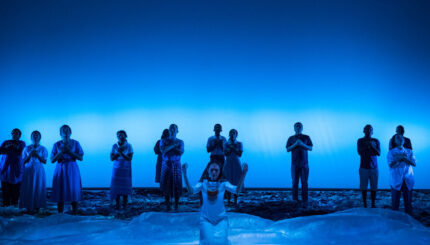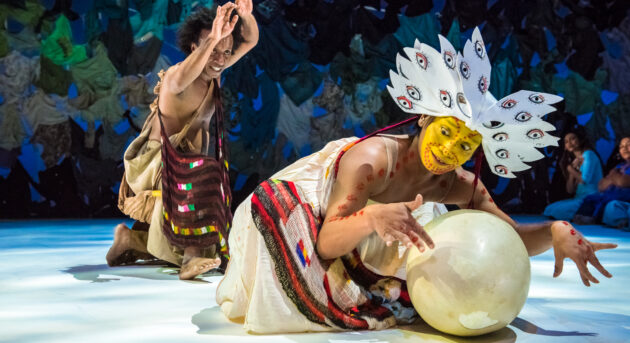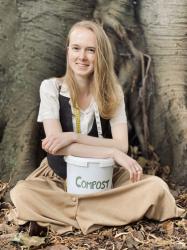The Composting Costumier talks The Planet – A Lament with Anna Tregloan
This interview took place across Wathaurong and Gadigal Land. I acknowledge the Australian Aboriginal and Torres Strait Islander peoples as the first inhabitants and Traditional Custodians of the nation and pay my respects to their Elders past and present.
“The Planet – A Lament” was part of a the Asia TOPA festival supported by Arts Centre Melbourne at the beginning of 2020. While Arts Centre Melbourne begins to open up outdoor events in December, their Together With You program will continue to be available online, where you can watch a digital showing of “The Planet – A Lament” as part of Asia TOPA Connected.
This article is part of a two part series that also includes an interview with director Garin Nugroho.
CC: What was the process like for Asia TOPA’s The Planet – A Lament, were you approached as an environmentally conscious designer or was there a more organic history of collaboration there?

AT: My involvement with The Planet – A Lament, came about the way many collaborations do, through a slow build of relationships over several years. I think it was Michael Kantor (whom I have worked with many times over fifteen years or so) who first suggested me to Garin Nugroho. I had however also met Garin and learnt about the project four years earlier as part of an AsiaTOPA development lab. Fortuitously, I had also undertaken research and work in Indonesia over those same years both on my own projects and in collaboration with quite a few different artists. That experience made understanding and implementing ideas and plans for the Planet much more streamlined.
To be honest the idea that I try to work with an ethos of environmental responsibility in mind never came up. Although Garin knew my work and Michael knows me well and is also passionately involved in this area; so I would guess it played a part when thinking about who would be a good fit.
CC: Was there anything different about working on this style of production where both subject matter and functionality are environmentally focussed? In terms of the way the team worked together or choices made? As opposed to companies where sustainability is perhaps an addition rather than an intrinsic part of the production.
AT: Working on projects where the subject is the state of the world, and currently implicit in that is environmental sustainability, does make bringing conversations about the sustainability of the production to the table more natural. Too often, as we all work under tight deadlines and tiny budgets, adding a consideration of eco system responsibility can be seen as an extra burden that even the very best people do not feel able to add to their load. The load is no less in a project focussed on those same issues but because it is part of the thematic and creative ethos it more easily segues into the production ethos.

Although as an artist and designer I can often control the materials and methodology of the staging and costume construction, usually the bigger picture like how things are packed for transport or what is transported or built on location is out of my control. The Planet was a very small team and that meant that we worked through everything together, in turn that meant someone in the group would bring up the ‘footprint’ as part of us working out the best approach.
Even then I wouldn’t claim we did everything perfectly. There is a difference between the Australian, the European and the Indonesian understanding of sustainability. And international shipping along with travel is fraught. And there were some design choices that I wish had had more sustainable solutions. For example there is one large plastic curtain that texturally, metaphorically and narratively was the perfect material (it also happened to be inexpensive which was a very real pressure on The Planet). I searched long and hard for organic, non plastic solutions as well as creatively for other ways of achieving a similar effect. In a few years perhaps an alternative material will be available but at the moment there was none I could find. Although it is a favourite moment for the audience and a metaphor of plastic swallowing the world is implicit in it; I always feel slightly defeated every time I see it.
CC: I believe that the 2020 season of The Planet – A Lament was the second iteration of this production? Did you find anything developed or changed in this remounting? If so were any of these changes impacted by / did any of these changes impact the environmental approach of the process?
AT: The season at the Art Centre was the premier season of The Planet. We had a sort of preview/ work in progress presentation in Jakarta prior to that. Because the production implicitly required travel, we planned the process so that each stage got the maximum artistic value from every flight. So, when we learnt that the fabulous Timorese Choir and Papuan dancers had no choice but to travel to Jakarta to obtain entry visas to Australia, we took advantage of that to gather and develop the work further and present it to a live audience in Jakarta. This turned out to be an irreplaceable opportunity to test most aspects of the production. Taking full advantage of that same trip also meant I could have the backdrop of second hand clothes and the gold leaf disk made in Jakarta. With our budget, neither of these things would have been achievable in Australia. And making these and the costumes in Indonesia undoubtably added to their authenticity. Between Jakarta and Melbourne quite a lot of fine tuning took place but pushing ourselves in Jakarta certainly gave us more confidence in opening in Melbourne.
CC: What role did design elements of Indonesian culture play within your design process, especially in how they tied in with elements of sustainability?
AT: Over the course of this production I felt extremely lucky to have worked in Indonesia previously. Cross cultural collaboration is both rewarding (for the individual growth and cultural diplomacy) and challenging. Actually working and living with people over an extended period (even if broken up) is the only way it is really achieved. In a Covid precursor, a lot of the meetings happened via zoom, but what we could achieve in those meetings was limited. It is worth noting that, while everyone gave it a go and many knew a bit, only one person on our team of thirty was fluent in both English and Bahasa Indonesia and not one person spoke all of the languages (which included Papuan, English, Timorese, Javanese and Indonesian).
My intent on this, and all cross cultural collaborations, is not to integrate one culture into another. Rather it is a question of what can we achieve together that would not happen if we were separate.
It is in that way similar to any collaboration. And what I enjoy most on productions like these is when you cannot tell which culture or artist an idea came from. That is something which could never be achieved separately but could happen when working together. Not only is that what true collaboration is, it also enables unique and connected works.
There are direct and indirect links to moving to a more sustainable methodology in that. Real shifts towards a sustainable practice are about shifting the way we think, make and share work.
The sort of openness to new techniques you embrace working cross-culturally is the sort of attitude we need to shift to more sustainable design and works.
CC: What do you see as the biggest environmentally conscious success of this particular production? Likewise, what challenges did you face and how did you approach or solve those?
AT: I am most interested in how sustainability integrates with a production and the points where, by embracing it, a more satisfying and complex work is made.
The wall of clothes which we collected from a second hand market in Timor and sewed together in Jakarta was this sort of experience. Yes, it was a sustainable choice but the story embedded in that choice ran deep and neither sustainability nor story led the idea: they arrived together and were inseparable.
These were clothes discarded by people in wealthier nations frequently worn only once and which through a network of buyers and sellers found their way to this market in Kupang. Kupang is the town where the choir live and where we spent time developing the work. The area is not wealthy and the contrast between these shiny clothes and lifestyles of much of the town was stark. Given that The Planet reflects on effects of a tsunami there were also resonances of both the massive amount of clothing donated to disaster zones and the way clothes wash onto beaches and become tangled with other detritus. And of course, the way clothes imply a human form and personal connection carry emotional weight.
I have a photo of the clothes we pulled from the market bundled together on a trailer and being pulled by a man on a push bike down the dirt path which ran through the market. On a stiflingly humid day we had been up to our thighs in these clothes which although clean were damp and smelly in the heat. I had never built a set like this before. Many things in Indonesia seem at first more complicated than Australia but the vast number of people means skilled hands are easier to find. That meant we could layout the arrangement and stitch each piece of clothing to the next in a way I don’t think we could have in Australia.
There were plenty of challenges, including the plastic curtain and the requisite travel mentioned before. My approach to those challenges is to first look at every alternative you have and then if they are unavoidable make sure that absolutely every advantage that can be gained from them is, so as little as possible is wasted.
CC: Has environmental responsibility always been a part of how you live and work? If not what was the instigator for your increased focus on this area?
AT: I was brought up to question why one would light an empty room and before eco consciousness was really a thing I ran my life on it. When the first wave of environmental consciousness broke (about twelve years ago) I was fascinated by why companies seemed to be leading the dance.
As far as I could see the choice to become an artist was by its nature an anti-consumerist and therefore a more sustainable notion. So much about art is about finding satisfaction in experience rather than owning and focused on the crafted and bespoke rather than mass produced and disposable.
Additionally and particularly in their early career (and often throughout) very few people become wealthy as an artist. As a privileged, intelligent and educated adult one simply does not decide to become an artist unless you are willing to forego the consumerist principles of ‘buy new and replace’ at every opportunity.
What I did realise about twelve years ago was that the values by which I lived my life were not always the same as how the work I was involved in was made. I also knew that just surface fixes, driven at the presentation stage, were not enough.
Real change needs to happen on every level of a project and can drive a new era of works.
Slowly, with the growth of community centred projects and less linear models we are seeing this emerge, although there is a way to go. I find the prospect of discovering new ways of working very exciting, even if protecting the eco system was not a priority I would be interested in this.
CC: Is environmental responsibility something you find you’re able to bring into the discussion in all your projects, whether or not they are collaborations or self-produced? Why or why not?
AT: It is part of all projects to a greater and lesser extent. It depends on my relationship to the project and what parts of it I can directly control. It would be better if it was a high priority to all teams on all projects, but often works are under so many pressures that people don’t feel able to cover all the detail they might hope. Often the place where we fall down is driven by budget where constraints too frequently drive managers to the most financially cost-effective choice rather than the best choice. This is changing as the importance of sustainability is more central to more people’s thinking, however there is still a way to go.
Worryingly at this moment is that more detailed thinking about environmental choices seems to happen when times are good and we, as a society, are not under the pressure of a recession. So environmental activism gained traction in 2008 but the recession of the following year sidelined it. Similarly the recent season of devastating bush fires meant the Australian public became fully awakened to the issue, but the devastating economic impact of Covid may put pay to that. Quite obviously this is worrying, to say the least.
CC: Can you speak a bit to the process you went through for Bell Shakespeare’s Twelfth Night and what similarities there might have been both conceptually and practically between that process and The Planet – A Lament, and also what links there are with your own produced works?
AT: It wasn’t until I was well into the process of The Planet that I even clocked to the connection between these two projects. Although retrospectively of course the research I did for Twelfth Night obviously fed the concept for The Planet.
It is probably worth noting that second hand items are something that I have used fairly continuously over the years and my own works routinely explore the idea of the found and the multiplicity of stories embedded there.
The design for Twelfth Night came through research into the aftermath of the Black Saturday bush fires in Victoria. Lee Lewis the director had already come to me with the premise of the fires and so I was looking for ways to represent that moment in staging which had to work in the rigorous restraints of the Bell Shakespeare touring schedule. Through research I discovered many images of rooms filled with clothes, clothes which were donated to fire survivors with the best intents but actually were more than the volunteer teams could manage or distribute. Twelfth Night is centered on an idea of attaining and then shedding new identities, so secondhand clothes (items that had once been part of someone else’s appearance) were a very useful tool. We bought everything from a charity, toured the country with it for sixth months and then donated them back to the charity.
CC: I love the concept of your self-produced works The Ghost Project and The Dictionary of Imaginary Places in how they investigate snapshots of individual’s stories and varying belief systems. A big part of their impact seemed to be in their installed, immersive, and adaptable formats. Is there something in this personal, emotive approach to productions and recognition of the ongoing lifespan and stories of objects that could be key to getting more conventional theatre makers on board with sustainable practices? In a way that’s embedded in the creative process rather than just an addition?
AT: The methodology behind the The Dictionary of Imaginary Places is something that gradually grew and emerged in my practice. I have always used secondhand items, both for environmental reasons but also the stories they inherently carry in them. This work really embraced the idea of ‘found’ by using verbatim conversations which I ‘found’ on the train system. In essence it was a rolling collage of the found texts, costumes and props.
The Ghost Project built on this but really honed an approach to making more sustainable work. It works in a few ways. It works locally (collecting local stories, but also objects, performers and materials in whichever town or city it is being presented) but it also uses every stage of it as building blocks for future stages. So it is specific to each town but nothing found goes to waste. Additionally it is made to be flexible and modular so that small sections can break off and be shown independent of the whole or for larger installations many parts of past versions can be shown as intersecting with each other. Simultaneously, in those large versions, new local stories and content will be created to add to the whole.
I am now using a similar methodology on a new project “The Impossible Project”. It sets out to find projects which have, for what ever reason, become impossible. It has the potential to be reformatted in many ways and again brings together these remnants of the past to create something new. My aim is that it will also create imagined but currently unattainable possible futures. Of course when something is unattainable we naturally ask ‘why?’ and so over all the project asks why some things happen easily and why we are told some things are impossible.
CC: Lastly, do you have any outside of the industry, personal sustainability tips you’d like to share? Anything to say about compost?
AT: My relationship with my worm farm is not unlike a pet owner. I even put some of my most fabulous worms in a show once (it was about Richard lll). They are amazing, not in any way sexy, but composting royalty and eat almost anything while fertilising my tiny inner-city garden.
Through this article, Anna would like to promote the Country Needs People campaign and petition, and support Madgin-Gal Women’s Place in Sydney.




